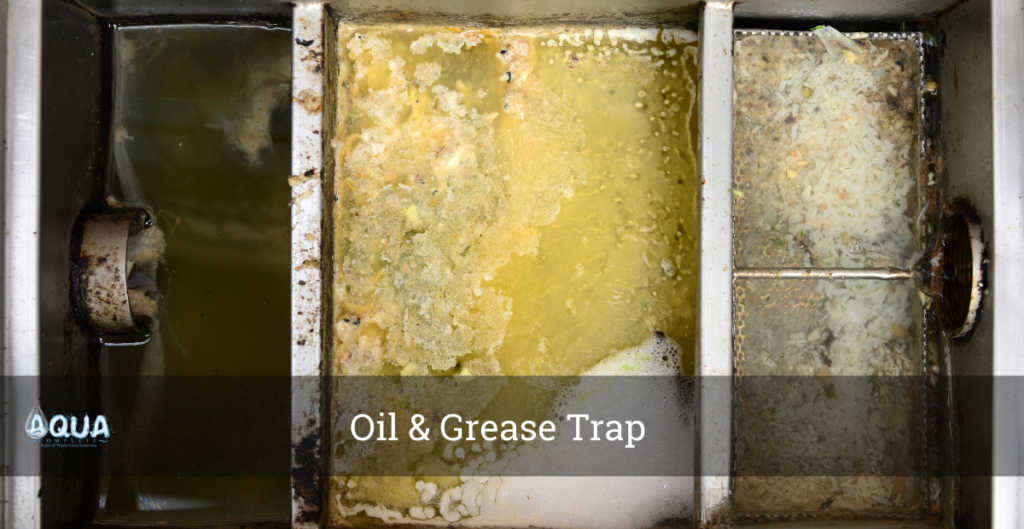What is an Oil & Grease Trap?
An oil & grease trap is a device designed to capture and separate fats, oils, and grease (FOG) from wastewater before it enters the drainage system. These substances can cause blockages, foul odors, and environmental pollution if not properly managed. Grease traps are essential for restaurants, commercial kitchens, and food processing industries to ensure compliance with local regulations.

How Does an Oil & Grease Trap Work?
Grease traps function by slowing down the flow of wastewater, allowing FOG to float to the surface while heavier solids settle at the bottom. The process includes several steps:
1) Wastewater Enters the Grease Trap
- Wastewater from sinks and dishwashers flows into the grease trap chamber.
- Larger food particles settle at the bottom, while grease and oil rise to the top.
2) Separation of FOG
- The trap retains FOG in a separate compartment, preventing it from entering the main drainage system.
- The cleaned water exits the trap and continues through the sewer system.
3) Periodic Cleaning & Maintenance
- Over time, the grease trap fills with accumulated fats, oils, and solids.
- Regular maintenance is required to prevent clogs and ensure proper functioning.
Types of Oil & Grease Traps
Various grease trap systems cater to different industry needs. The main types include:
1) Passive Grease Traps
✔ Installed under sinks or near kitchen drainage systems.
✔ Uses gravity to separate grease and solids from wastewater.
✔ Requires manual cleaning and maintenance.
2) Automatic Grease Removal Units (AGRU)
✔ Uses mechanical skimmers to remove FOG automatically.
✔ More efficient for high-volume kitchens and industries.
✔ Reduces maintenance frequency and improves compliance.
3) Gravity Grease Interceptors
✔ Large-capacity units typically installed underground.
✔ Used in commercial settings with high grease production.
✔ Requires professional servicing for periodic cleaning.
4) Hydro-Mechanical Grease Traps
✔ Combines water flow dynamics with filtration.
✔ Compact and effective for small-scale food establishments.
✔ Provides improved separation efficiency.
Why Are Oil & Grease Traps Important?
Proper grease management offers several key benefits:
✔ Prevents Drain Blockages – Reduces pipe clogs and costly plumbing repairs.
✔ Complies with Regulations – Ensures adherence to environmental and health codes.
✔ Protects the Environment – Reduces grease buildup in public sewers and water bodies.
✔ Improves Hygiene – Prevents foul odors and maintains a clean workspace.
✔ Extends Septic System Life – Prevents excessive FOG buildup in wastewater systems.
Where Are Oil & Grease Traps Used?
Grease traps are essential in industries and businesses that handle food and oil-based products.
1) Restaurants & Commercial Kitchens
- Prevents grease-related blockages in drainage systems.
- Helps comply with food safety regulations.
2) Food Processing Plants
- Manages large volumes of grease and waste effectively.
- Ensures wastewater meets environmental standards.
3) Hotels & Catering Services
- Maintains efficient kitchen operations.
- Reduces odor and sanitation issues.
4) Automotive & Industrial Facilities
- Used to capture oil and grease from vehicle wash stations.
- Prevents contamination of sewage and stormwater systems.
How to Maintain an Oil & Grease Trap?
Regular maintenance is crucial to keep grease traps functioning properly. Follow these best practices:
✔ Monitor Grease Levels – Check accumulation levels frequently.
✔ Schedule Routine Cleaning – Clean manually or hire professionals based on usage.
✔ Dispose of Waste Properly – Never pour grease directly down the drain.
✔ Use Biodegradable Cleaners – Avoid harsh chemicals that may harm the system.
✔ Keep Records – Maintain logs of maintenance activities for regulatory compliance.
Choosing the Right Oil & Grease Trap
Selecting the right grease trap depends on several factors:
✔ Business Type & Waste Volume – Choose a trap size based on grease output.
✔ Installation Space – Ensure the unit fits within your kitchen layout.
✔ Maintenance Requirements – Consider ease of cleaning and frequency.
✔ Regulatory Compliance – Follow local health and environmental guidelines.
Final Thoughts
An oil & grease trap is essential for any business handling greasy wastewater. Proper selection, installation, and maintenance prevent costly plumbing issues, ensure regulatory compliance, and promote environmental sustainability. Investing in a reliable grease trap system helps keep your operations smooth and efficient.
